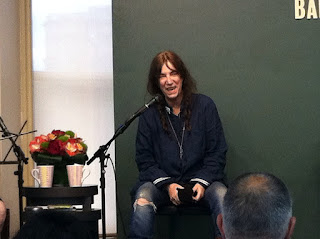A wave of deep sadness washed over me as I learned the news of Jimmy Scott’s passing. After that, gratitude. I am so blessed to have seen Jimmy Scott sing live.
It was a steamy June evening in 2012, in the basement supper-club of the popular Red Rooster Restaurant in Harlem. Amidst the distant clattering of dishes and the clinking of wine glasses, Scott entered, humble, and clearly moved by his ecstatic reception, wheelchair-bound and physically frail, but with a fierce determination and passion that flickered across his smiling face. A microphone was lowered, and for the next hour or so, Scott closed his eyes, furrowed his brow, and had the intimate room spellbound.
I first stumbled across the recordings of Jimmy Scott as a teenager. Some of the artists I admired had mentioned him as an inspiration in interviews, and, trusting them as great arbiters of taste, I followed their advice. This time period coincided with my discovery and embrace of a lot of jazz sounds: Ella Fitzgerald (whom I saw live a few years later), Miles Davis (who I’d already seen live, scant months before his passing), Dizzy Gillespie (who again, I saw live before his passing), Billie Holiday (alas), and Frank Sinatra (who I wish I could take a time machine to see live in the 1950s). While Little Jimmy fit within that jazz world, to say he was a “jazz singer” would, for me, be sticking him in a bin that was a bit too narrow for what he did, and really, who he was. Just as he himself defied norms (not at all by choice), his voice — and the way he used it — defied conventional categorization. He belonged in an ornate church the way he belonged in a smoky jazz club; that is to say, he was a bit of everything, embracing, synthesizing, integrating influences and styles, but then re-making, re-creating and expressing something wholly and entirely his very own. As Anthony Hegarty put it to The Quietus in 2011, he “sings like a sobbing diamond.”
It’s this very individuality and subsequent beauty that so astonishes and quiets us.
And yet, some might argue it cost him mainstream success. Jimmy’s name isn’t as well-known as say, Sinatra, or Dean Martin, or Tony Bennett. He doesn’t have the cachet of his jazz-singer brethren. But again, Jimmy wasn’t just one thing. He worked with Lou Reed and David Lynch; he was in a Hal Willner-produced tribute concert for Harry Smith; he was name-checked as inspiration by a variety of artists, including Nick Cave, Van Morrison, Bruce Springsteen, and Madonna, the latter saying Jimmy was the only singer “who’d ever really made me cry.”
Lou Reed had said, “we all bow at the altar of Jimmy Scott.” Lou, I think, understood Jimmy in a profound way; both of them appreciated the deep relationship that has to exist between identity, artistry, beauty, and authenticity. Lou got it; Jimmy got it. And, in the brief moments the world had them, we, the audience, got it.
To say the experience of seeing Jimmy live was special would be far too reductive and trite; to say it was akin to going to church would be too predictable. There was something other-worldly, haunting, and wholly transcendent about hearing him live. Recordings may flit at the edges of his greatness, but, like a great opera singer (Pavarotti) or a wondrous instrumentalist (Gillespie, Davis), the nature of art, to say nothing of how we, the audience, experience it, changes in a dramatic way within the live realm. Never mind style; Jimmy Scott’s whole soul — in life, in love, in art, in sound and fury — was expressed in the blessed short hour I and the rest of Ginny’s Supper Club had with him that night. Experiencing Little Jimmy live re-affirmed the centrality of music and culture in my life, and reminded me of my responsibility to the authentic in everything I write and do. Sometimes we are all motherless children; Jimmy made us know, understand, and find the beauty in the pain, the pain in the beauty, always, unquestionably, unapologetically himself.


